The Great Pacific Garbage Patch is a vast collection of marine debris found in the central North Pacific Ocean.
―
What is Great Pacific Garbage Patch?
―
A. The Great Pacific Garbage Patch (GPGP) is a vast collection of marine debris found in the central North Pacific Ocean between California and Hawaii, USA.
It spans an area of approximately 1.6 million square kilometers and weighs around 80,000 tons. Shockingly, it contains an estimated 1.8 trillion pieces of plastic trash, equivalent to the weight of 500 large airliners.
Not only that, this patch of trash is getting bigger and bigger. Experts predict that there will be more trash in the ocean than fish by 2050 if it continues to grow at the current rate.
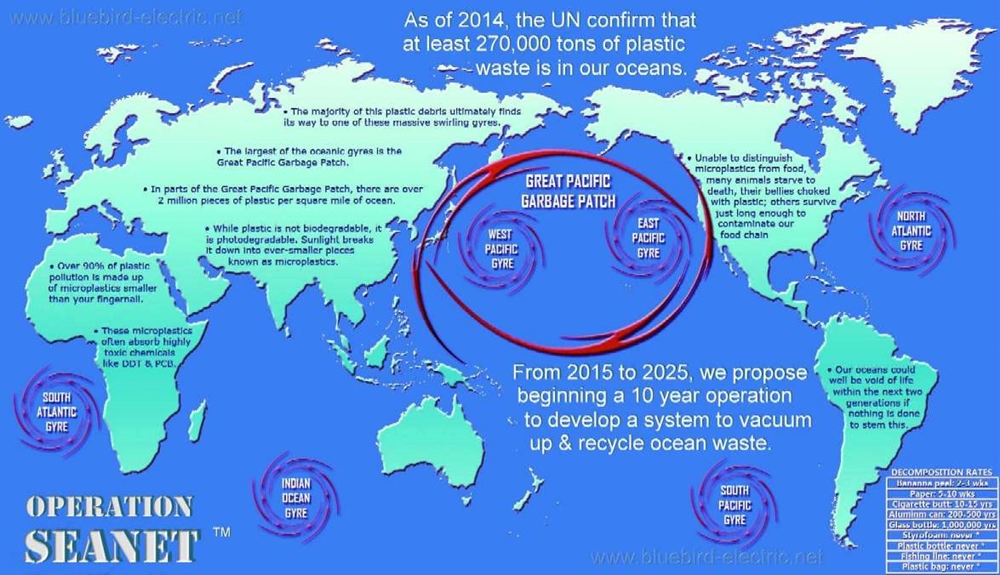
Source: The Ocean Cleanup
―
GPGP becomes the nation of Trash Isles
―
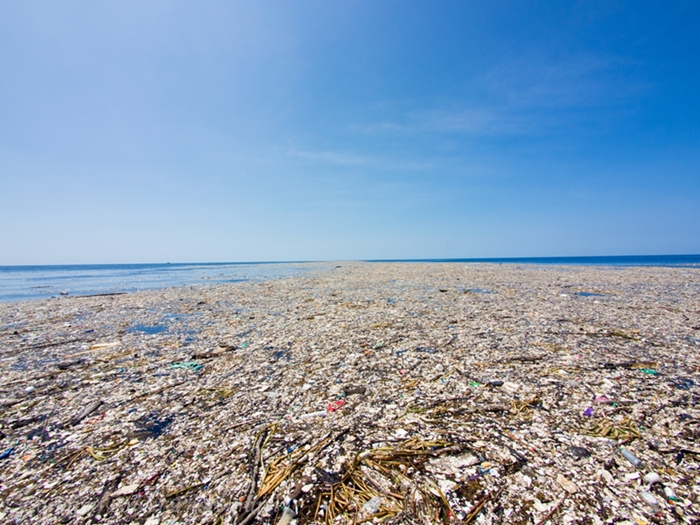
The Great Pacific Garbage Patch was first discovered in 1997 by Charles Moore, a racing boat captain, during his returning trip from a trans-Pacific race from Los Angeles to Hawaii. This discovery of a giant patch of plastic junk floating in the ocean prompted a warning to the world about the seriousness of ocean pollution.
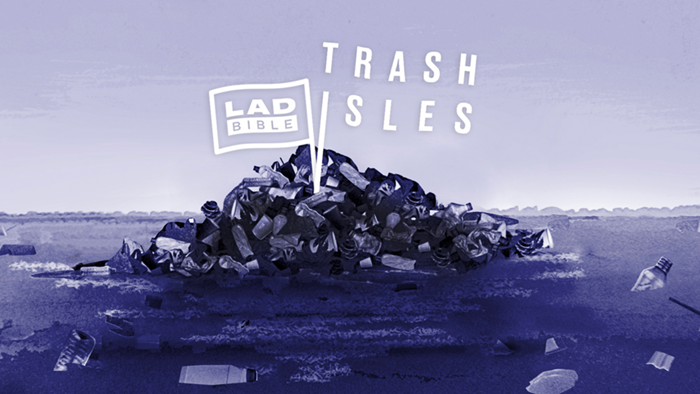
Source: LAD Bible
In celebration of World Oceans Day 2017, the Plastic Oceans Foundation and the LADbible Group teamed up to take this trash patch and turn it into a nation. The idea was that if it were recognized as a nation by the United Nations, then neighboring countries are obliged to clean it up.
It was officially named the Trash Isles. They established a government, drew up borders, and recruited citizens. Al Gore, former US Vice President and a well-known environmentalist, became the island’s first citizen. And Judi Dench, who played M in James Bond movies, was named the Queen of Trash Isle.
Today, it has its own flag, passport, and currency, and more than 200,000 people have joined Trash Isle as “citizens” through the online platform. The currency is in “debris,” and it features images of sea lions and seagulls wrapped in plastic nets and whales swimming in a sea of plastic.
Trash Isles currency
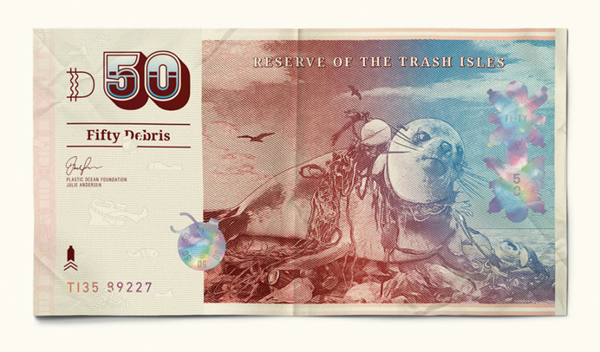
Trash Isles Passport
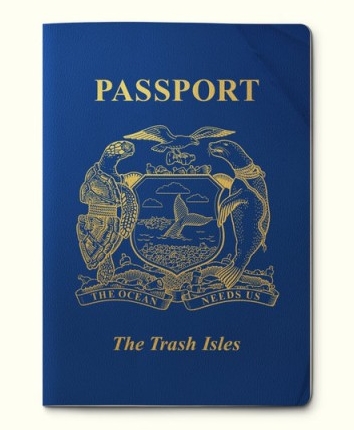
(Video : The Trash Isles from Dalatando Almeida)
―
Q. How was the Great Pacific Garbage Patch formed?
―
A. The formation of the Great Pacific Garbage Path is attributed to wind and ocean currents that have accumulated marine debris in one area over time.
The Ocean Cleanup, a Dutch non-profit research organization, conducted extensive international research of the GPGP in 2018. After 3 years of research, they discovered that the resulting from the 2011 Great Japan Earthquake was transported by the Kuroshio Current, which flows from Asia towards the North Pacific Ocean. And a significant proportion of the trash found in the “island” consisted of Japanese (29.8%) and Chinese (30%) labels.
For further scrutiny, the Ocean Cleanup team categorized the collected plastic into four size classes.
▲ Microplastics: 0.05~0.5cm
▲ Mesoplastics: 0.5~5cm
▲ Macroplastics: 5~50cm
▲ Megaplastics: anything above 50cm
Megaplastics, weighing 42,000 tons, accounted for the largest portion of the debris, with 46% comprising fishing nets or aquaculture nets. Microplastics made up 5-10% of the total garbage, and their concentration is expected to increase as plastics persist in the region and break down into smaller pieces within the Great Pacific Garbage Patch.
―
GPGP is a result of human-activity
―
It is important to note that the Great Pacific Garbage Patch is the result of human-activity. The production of plastic has skyrocketed since the 1950s, and the Food and Agriculture Organization (FAO) reported that approximately 8.3 billion tons of plastic have been produced by 2017 (Microplastics in fisheries and aquaculture). This is equivalent to the weight of 1 billion elephants.
Plastic production continues to increase. In 2015 alone, 322 million tons of plastic products were produced, and the number is expected to double by 2050. A significant portion of this plastic, over 80%, is discarded, and approximately 12 million tons find their way into the ocean each year. That is one truckload of plastic dumped into the ocean every minute, posing a severe threat to the marine ecosystem and humans.
―
Dangers of GPGP
―
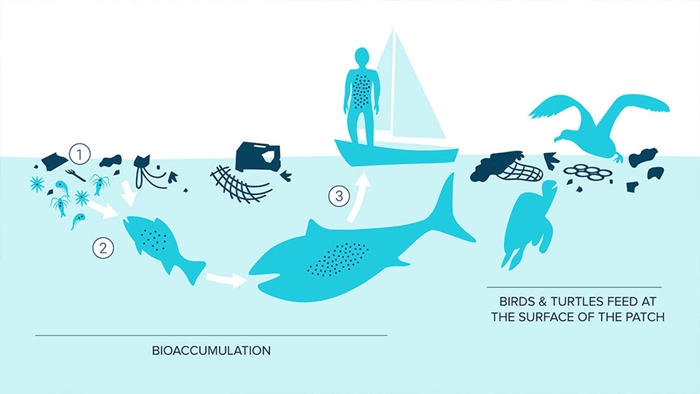
How plastic finds its way into the ocean
Source: The Ocean Cleanup
Marine plastic left floating on the ocean
Poses a threat to the marine ecosystem and humans.
The dangers associated with the Great Pacific Garbage Patch are manifold. Marine animals often mistake shiny microplastics for food, leading to ingestion and subsequent health issues such as stunted growth and reproductive problems.
Microplastics have also been found in the seafood that we consume, including fish like swordfish and bluefin, as well as mussels and oysters. Even salt has been found to contain traces of microplastics.
Recently, scientists have found microplastics in more than 18% of the fish samples from the Mediterranean Sea. And another study by the WWF (World Wide Fund) and the University of New Castle in Australia has reported that individuals may be consuming around 5 grams of microplastics per week, which is equivalent to the size of a credit card.
Addressing the Great Pacific Garbage Patch requires concerted efforts. It is crucial not only to clean up the existing plastic debris to eliminate the GPGP, but also to work towards reducing the amount of plastic that ends up in the ocean. By taking action, we can safeguard marine life and protect our own health from the detrimental effects plastic pollution.
“Nature and we humans are inextricably linked.”
-Dr. Hak Ja Han Moon,
Founder of the Sunhak Peace Prize-
Learn more: Plastic Island Floating in the Sea |
Written by Sharon Choi
Director of Planning
Sunhak Peace Prize Secretariat
Translated by Hyang Oh

